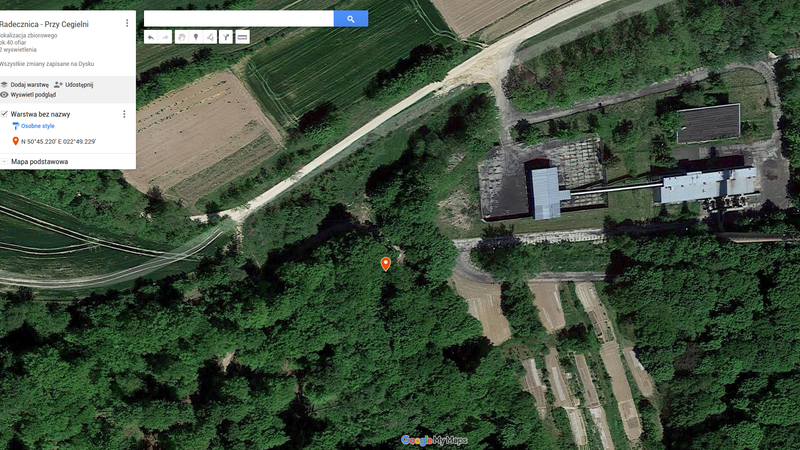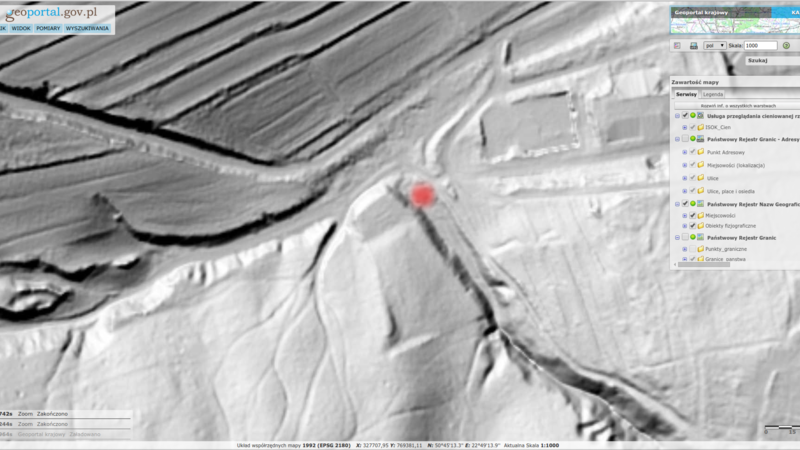Radecznica at the brickyard
gmina Radecznica, powiat zamojski, województwo lubelskieType of place
The area of the former Brickyard in Radecznica.Information about the crime
The existence of unmarked Jewish graves of the Holocaust victims in the village of Radecznica was brought to our attention by a letter from Stanisław Zybała (a resident of the village, born in 1930) written on 6 October 2010 to the Jewish Religious Community in Lublin and passed over to the Rabbinic Commission for Cemeteries. There was a map drawn by Mr Zybała and attached to the letter which indicated the sites of burial of the murdered Jews.
One of the places of the Jewish torture in Radecznica was the area surrounding the Brickyard. Stanisław Zybała told us about it in 2013:
“There was an execution on the square in the Brickyard. One of them, he was called… Judka – he lived on Zielona Street – he walked around, struggling, hiding… Finally, he was so tired of it that he told people, also my father-in-law (my wife’s stepfather): ‘The world is so big but I have nowhere to hide.’ And in the end he went to the police station and asked them: ‘Kill me, please, I can’t stand it anymore’. And a time came when they took him… because he was locked up in a cell. Close to the old council building. Next to the turning, there used to be an old council building. It was built in tsar’s times. And then they took all of them out, even the mother of Rubin [Weistuch] – Rubin ran away but his mother came back from the forest; she was scared to go home and ended up in jail. And Rubin brought them food to the jail from the Krukowski family. It took several days before they gathered more people. Then they took all of them and brought them here for the execution. […] And probably Judka was here [too]. When they shot him, they didn’t kill him. They shot him in the stomach. He begged to be killed but none of the people [ordered to] bury bodies could do it. They said: ‘Judka, maybe you’ll die on your own.’” (Radecznica, 28 July 2013.)
Murders of Jews near the Brickyard in Radecznica are also mentioned in the execution chapter from the archives of the Chief Commission for Investigation of Hitlerite Crimes in Poland (IPN BU 2448/608). It says that in July, October, November and December 1943 and in January 1944 executions in which 43 people were meant to die took place there. 7 people would die near the house, 20 people in the monastery woods, 6 people near the brickyard and 5 in the monastery woods.
According to Mr Zybała there are at least two unmarked Jewish graves in the area – one of them next to the brickyard and the other in the monastery park. On the aforementioned map he put an information that the murders in the brickyard took place in the second half of 1943 (“from October till the winter of 1943”.) According to Mr Zybała, this small area may be the resting place of up to 70 Jews – victims of the Holocaust (including approx. 12 people buried in the monastery park.)
Commemoration
The site of the grave has been marked with a symbolic wooden matzevah put up as a part of the “30 matzevahs in 30 days” project in September 2017 – its objective was to mark places of the Holocaust in southern and eastern Poland. The partner of the project was the American Matzevah Foundation.

IDENTIFICATION OF THE GRAVE BASED ON NON INVASIVE RESEARCH
On the 15th of October 2014 a local vision of the place of the mass grave indicated by the witness was carried out (GPS: N50°45.220’E022°49.229′). Precise location of the mass grave could not be determined.
There are no conditions in this location to carry out reliable GPR surveys.
The LIDAR survey is not helpful in this case.
The aerial photography query for this area wasn’t ordered.
 Radecznica - Przy Cegielni fotografia satelitarna 4 lokalizacji Przy Cegielni
Radecznica - Przy Cegielni fotografia satelitarna 4 lokalizacji Przy Cegielni Radecznica - Przy Cegielni lidar 1i cegielnia
Radecznica - Przy Cegielni lidar 1i cegielnia Radecznica - Przy Cegielni fotografia 5 lokalizacja przy cegielni
Radecznica - Przy Cegielni fotografia 5 lokalizacja przy cegielniTranskrypcje
Contact and cooperation
We are still looking for information on the identity of the victims and the location of Jewish graves in Radecznica. If you know something more, write to us at the following address: fundacjazapomniane@gmail.com.
Bibliography
Recording of the Zapomniane Foundation (audio file), name: Stanisław Zybała [eyewitness], b. 1930, subject and keywords: Jewish graves in Radecznica, interviewed by Agnieszka Nieradko, Radecznica, 28 July 2013.
Zybała M., Zybała Rozwar S., Tak Cię widzę Radecznico, Radecznica 1998-2000.
Grzeszkiewicz Smoter R., Zybała Rozwar S., Ludność żydowska w gminie Radecznica, Szczebrzeszyn 2015.
GK 163/19, p. 1299, Questionnaire of places and facts of German crimes carried out by town courts. Lublin province. Questionnaire. Executions. Graves Lubelskie province; vol. 8, p. 1299.
IPN BU 2448/607, 608, Questionnaires of the Chief Commission for the Examination of German Crimes in Poland, Zamość district.
IPN BU 2448/608 from the files of the group Questionnaires of the Chief Commission for the Examination of German Crimes in Poland.
IPN Lu 1/13/78 cards 140, 140v, 141, 141v, the former Regional Commission for the Examination of German Crimes in Lublin, Questionnaire of places and facts of German crimes, Zamość district.
The register of sites and crimes committed by the Germans in Poland between 1939 and 1945, Warsaw 1994, Zamojskie province, p. 110.
A letter by Stanisław Zybała of 6 October 2010 to the Jewish Community in Lublin on Jewish graves in Radecznica along with a handwritten map of the place where the author marked the approximate locations of burial sites.
Marianna Zybała’s statement of 23 May 2016 on the location of the grave on the so-called “Drugie Doły” certified by the Commune Office in Radecznica.
Grzeszkiewicz Smoter R., Zybała Rozwar S. Rzeczpospolita Radecznicka, Lublin 2008 p. 120-126.
Zybała Rozwar S., Ulice Radecznicy, Szczebrzeszyn 2015.
Grzeszkiewicz Smoter R. Poza miastem poza historią. Rzecz o szczebrzeszyńskich Żydach, Szczebrzeszyn 2016.
Materials regarding Jewish war graves in Radecznica (transcripts of witness testimonies, video and audio files with eyewitness accounts) were prepared thanks to funding from the association of Jewish Historical Institute as part of the project: “Jewish War Graves. Documentation.”

 Radecznica przy cegielni - transkrypcja nagrań
Radecznica przy cegielni - transkrypcja nagrań